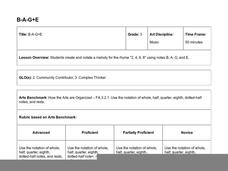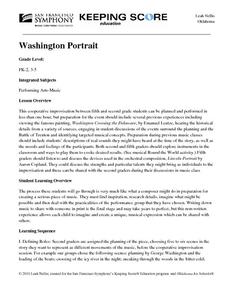Hawaiʻi State Department of Education
Finding the Main Idea
You can mix almost any subject with an arts curriculum. Find out how to use drama to find the main idea of a literary text. You'll read a story, and then learners will make tableaus showing what happened, or what they think will happen...
Hawaiʻi State Department of Education
Pilobolus
After reviewing dance-specific terminology and watching a clip from the dance troupe Pilobolus, learners create dances of their own. They pair up and use the teacher's cues to create creature dances that exemplify mood and shape. Any...
Hawaiʻi State Department of Education
What’s My Vocabulary Word?
The elements of dance can be used to communicate thoughts and, in this case, words. In small groups, the class first creates a set of movements to show a single word. Then, they extend their movements to show a three-word phrase....
Hawaiʻi State Department of Education
B-A-G+E
Budding musicians discuss rhythmic notation and melody as they play a bar instrument or recorder. They use the notes B, A, G, and E to play a simple melody, and then they use those same four notes to turn a poem into a song. They play...
Hawaiʻi State Department of Education
Crow Boy
There is a difference between actions, motives, and the appearance of a character in a narrative text. Fourth graders explore character analysis through the dramatic arts. They create a series of movements, tableaus, and pantomimes to...
Hawaiʻi State Department of Education
Gargoyles Galore
Grrrrr, gargoyles are on the loose! Young artists are familiarized with the history of gargoyles, examine pictures of them, and hear a story about them. Then, they draw a gargoyle and write down exactly how they did it (procedural...
Hawaiʻi State Department of Education
Rhythm Patterns
Fractions can be tricky. Why not have kids think of fractions like they think of eighth, quarter, and half notes? In teams, the class creates four-measure patterns with their percussion instruments. They need to explain their rhythm...
Hawaiʻi State Department of Education
Angles on Kandinsky
Not only is Wassily Kandinsky fun to say, his art contains tons of angles. Learners discuss Kandinsky's music-inspired abstract art and four types of angles. They search one of his paintings for obtuse, right, straight, and acute angles,...
San Francisco Symphony
Adding Music to Oklahoma History
To better understand Oklahoma state history, learners will use a website to find a song that supports or represents aspects of Oklahoma's history. They'll write three sentences defending their choice, and then they will create...
San Francisco Symphony
Quilt Making and Copland's Rodeo
Kids make quilts as they learn about pioneer life and the concept of tempo. The Aaron Copland piece, Rodeo is used to convey rhythm and tempo in music. As the children discuss tempo and rhythm, they also discuss what life was like for...
San Francisco Symphony
Learning Adjectives through the Duke
Duke Ellington, jazz, and jive kick-off a fun and creative lesson on responding emotionally to music. The class will learn about jive talk used in the 1920s and the life and music of Duke Ellington. They'll listen to a selection of his...
San Francisco Symphony
Heritage Song
Learning how to compare and contrast is a core skill. Learners compare two music selections that showcase a specific heritage. They draw and discuss how each song and the composers of each song used their personal heritage as...
San Francisco Symphony
Going West
Now this sounds like a fun lesson! Youngsters learn about pioneer life and the Westward Movement. First, they listen to the Copland's "Appalachian Spring," and then they discuss the elements of music found in the piece. They get into...
San Francisco Symphony
Washington Portrait
Fifth and second graders pair up to create mini dance scenes based on the image Washington Crossing the Delaware. Second graders create the movements while their fifth grade partners play the musical accompaniment. Leadership skills,...
San Francisco Symphony
Biographical Slideshow
Biographies can be a fun topic for any history project. Learners choose one famous person that lived between 1865 and 1930 to research. They gather information, work on reading comprehension, and use what they find to create slide shows...
San Francisco Symphony
Music and Early Man
Creative projects are great ways to increase interest in topical research. Middle schoolers learning about primitive life styles in the Americas explore the importance of music to hunter gatherers. They research and create musical...
Curated OER
Mozart vs. Beethoven - Real Classical Composers
Elementary schoolers are given an overview of the baroque, classical, romantic, and modern periods of music. They focus on the lives of Beethoven and Mozart; two of the greatest composers of all time. After listening to samples their...
San Francisco Symphony
Aaron Copland: Billy the Kid
Your class can think about the American Old West as they listen for dynamics, articulation, rhythm, and tempo in the Aaron Copland song, "Billy The Kid." They'll explore how Copland uses music to create an image of life for an outlaw in...
San Francisco Symphony
By the Great Horn Spoon!
By The Great Horn Spoon is a fantastic novel for introducing learners to life during the California Gold Rush. First, kids research and analyze American folk songs, then they connect to the text as they listen to symphonic pieces written...
Hawaiʻi State Department of Education
Cinderella
Reading fairy tales is so much fun! Learners use dramatic play to assist them in defining and expressing the main theme found in the story of Cinderella. Each group is given a story card and will create a tableau based on the main point...
Hawaiʻi State Department of Education
Comparing Cultural Dances
All cultures express similar thoughts, feelings, and ideas. But, often times those things are expressed differently. Learners compare and contrast traditional dances from two cultures. They watch videos of each performance, stop to...
Hawaiʻi State Department of Education
Spontaneous Inventions
Reading out loud can be a real thrill for some, and a real issue for others. Teach your class that reading with inflection and fluency can be as easy as singing a song. They'll first analyze two Bobby McFerrin songs for intonation,...
Hawaiʻi State Department of Education
Comparing Themes
The tale of "Lon Po Po" is a Chinese story, very similar to the European tale of "Little Red Riding Hood." Learners make cross cultural comparisons between the two tales, focusing on themes common to both. They review story elements such...
Acoustical Society of America
Musical Instruments
Mix it up and engage learners in a lesson on music and physical science. Using cups, strings, guitars, and voice, the class will experiment with sound vibration and frequency. They'll use each instrument and fill out a worksheet that...

























